Ingrown toenails can be painful and frustrating to deal with. While ingrown toenails can affect anyone, there are certain factors that increase the risk of developing them.
In this blog, we’ll discuss the causes of ingrown toenails and how to prevent them.
Improper Nail Trimming
Cutting your toenails too short or rounding the edges can cause the nails to grow into the skin. It’s best to cut your toenails straight across and leave a little bit of the white tip showing.
Tight-fitting Shoes
Wearing tight-fitting shoes can also contribute to the development of ingrown toenails. Shoes that are too tight can put pressure on the toes, causing the nails to grow into the skin. It’s important to wear comfortable shoes that fit properly and have enough room for your toes to move around.
Genetics
Some people are genetically predisposed to ingrown toenails. If other members of your family have had ingrown toenails, you may be more likely to develop them as well.
Injury
Injuries to the toes or feet can also cause ingrown toenails. Trauma to the nail or toe can alter the way the nail grows and lead to it growing into the surrounding skin.
Nail Conditions
Certain nail conditions, such as fungal infections or thickened nails, can increase the risk of developing ingrown toenails. These conditions can cause the nail to become misshapen and grow into the skin.
Symptoms of Ingrown Toenails
Ingrown toenails are a common condition that can cause pain and discomfort. Below are some common symptoms of ingrown toenails.
Pain and tenderness: The most obvious symptoms of an ingrown toenail are tenderness and pain. The pain may be constant or intermittent, and it may increase with pressure to the toe area.
Swelling and redness: Ingrown toenails can cause swelling and redness around the affected area. The skin may become inflamed and tender to the touch.
Infection: If left untreated, an ingrown toenail can become infected. Signs of infection include increased pain, redness, and swelling, as well as discharge or pus coming from the affected area. In severe cases, fever and other systemic symptoms may occur.
Difficulty wearing shoes: Ingrown toenails can make it difficult to wear shoes, especially those that are tight or have a pointed toe. The pressure from the shoe can cause increased pain and discomfort.
Overgrowth of skin: In some cases, the skin around the affected area may overgrow in response to the ingrown toenail. This can create a small, fleshy mass called a granuloma.
Changes in nail shape: Ingrown toenails can also cause changes in the shape of the affected nail. The nail may become distorted, thickened, or discolored.
Ingrown toenails can cause a range of symptoms, including pain, tenderness, swelling, and redness. If left untreated, they can lead to infection and other complications. If you suspect you have an ingrown toenail, it’s important to seek medical attention from an ingrown toenail specialist in Los Angeles to learn treatment options to alleviate your symptoms and prevent complications.
Ingrown Toenail Risk Factors
Ingrown toenails are pretty common. However, there are certain risk factors that can increase your likelihood of developing this condition.
Improper nail trimming: Trimming your toenails too short or rounding the corners can cause the nail to grow into the surrounding skin, increasing the risk of an ingrown toenail.
Footwear: Wearing tight shoes or socks can put pressure on the toes, increasing the risk of an ingrown toenail. Shoes with a narrow toe box are particularly problematic.
Foot shape: Certain foot shapes can increase the risk of an ingrown toenail. People with flat feet are more prone to developing this condition.
Genetics: There is a genetic component to ingrown toenails. If your parents or grandparents had this condition, you may be more likely to develop it as well.
Injury: Trauma to the toe can increase the risk of an ingrown toenail. Stubbing your toe or dropping something heavy on it can damage the nail, making it more likely to grow into the surrounding skin.
Understanding the risk factors associated with this condition can help you take steps to prevent it from occurring. Proper nail trimming, wearing comfortable shoes, and protecting your toes from injury can all reduce your risk of developing an ingrown toenail.
Ingrown Toenail Treatment
Ingrown toenails are a painful and uncomfortable condition. They occur when the edge of the toenail grows into the skin surrounding it, causing irritation, swelling, and in some cases, infection. Treatment for ingrown toenails depends on the severity of the condition.
For mild cases, soaking the affected toe in warm water with Epsom salt helps to reduce swelling and discomfort. Using a small cotton swab or ball to gently lift the edge of the ingrown toenail can also provide temporary relief.
For more severe cases, a doctor may need to trim or remove the ingrown toenail. This can be done in a sterile environment using local anesthesia to numb the toe. Afterward, the toe will be bandaged to promote healing.
In some cases, antibiotics may be prescribed to treat an infection that has developed due to the ingrown toenail. In severe cases, surgery may be required to permanently remove a portion of the toenail or the entire nail.
To prevent ingrown toenails from occurring, it is important to trim your toenails straight across and to avoid short and round edges. You should wear shoes that fit properly and avoid tight socks to reduce the likelihood of ingrown toenails.
If you are experiencing ingrown toenail symptoms, contact Dr. Harounian Podiatry to seek treatment from an ingrown toenail specialist in Los Angeles.









